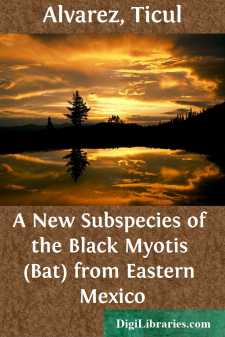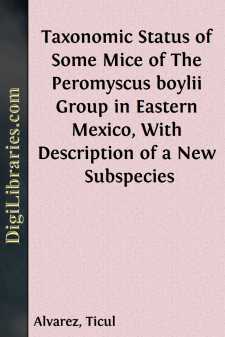Categories
- Antiques & Collectibles 13
- Architecture 36
- Art 48
- Bibles 22
- Biography & Autobiography 813
- Body, Mind & Spirit 142
- Business & Economics 28
- Children's Books 17
- Children's Fiction 14
- Computers 4
- Cooking 94
- Crafts & Hobbies 4
- Drama 346
- Education 46
- Family & Relationships 57
- Fiction 11829
- Games 19
- Gardening 17
- Health & Fitness 34
- History 1377
- House & Home 1
- Humor 147
- Juvenile Fiction 1873
- Juvenile Nonfiction 202
- Language Arts & Disciplines 88
- Law 16
- Literary Collections 686
- Literary Criticism 179
- Mathematics 13
- Medical 41
- Music 40
- Nature 179
- Non-Classifiable 1768
- Performing Arts 7
- Periodicals 1453
- Philosophy 64
- Photography 2
- Poetry 896
- Political Science 203
- Psychology 42
- Reference 154
- Religion 513
- Science 126
- Self-Help 84
- Social Science 81
- Sports & Recreation 34
- Study Aids 3
- Technology & Engineering 59
- Transportation 23
- Travel 463
- True Crime 29
A New Subspecies of the Black Myotis (Bat) from Eastern Mexico
by: Ticul Alvarez
Description:
Excerpt
In 1928 when Miller and Allen (Bull. U. S. Nat. Mus., 144) published their revisionary account of American bats of the genus Myotis, the black myotis, Myotis nigricans, was known no farther north than Chiapas and Campeche. Collections of mammals made in recent years for the Museum of Natural History of The University of Kansas include specimens of M. nigricans from eastern Mexico as far north as Tamaulipas. Critical study of this newly acquired material reveals that it pertains to an hitherto unnamed subspecies that may be named and described as follows:
Myotis nigricans dalquesti new subspecies
Type.—Male, adult, skin and skull, No. 23839 Museum of Natural History, University of Kansas; from 3 km. E of San Andrés Tuxtla, 1000 ft., Veracruz; obtained on January 5, 1948, by Walter W. Dalquest, original No. 8444.
Range.—Tropical Life-zone of eastern México from southern Tamaulipas to central Chiapas.
Diagnosis.—Color black or dark brown, venter having brownish wash; size large (see measurements); M1 and M2 quadrangular; prominent protostyle on P4; P2 and P3 in straight line; sagittal crest absent.
Comparison.—Color almost as in Myotis nigricans extremus, the subspecies occurring adjacent to dalquesti in Chiapas and Tabasco. From M. n. extremus, dalquesti differs as follows: larger; hypocone in M1 and M2 broader making posterointernal part less rounded; protostyle of P4 prominent instead of absent; P3 in line with C and P2 instead of displaced lingually; sagittal crest absent instead of present posteriorly. Myotis nigricans nigricans and M. n. dalquesti are of approximately equal size; otherwise they differ in the same features as do extremus and dalquesti.
Measurements.—Average and extreme measurements of seven males from the type locality, followed by those of 19 females from 38 km. SE Jesús Carranza, and finally length of forearm and cranial measurements of eight female topotypes of M. n. extremus, are as follows: Total length, 80 (77-82), 76 (72-80); length of tail, 32.8 (30-35), 33.5 (31-35); hind foot, 7.9 (7-8), 8.0 (8-8); forearm, 34.2 (33.6-35.3), 35.1 (33.1-36.4), 33.1 (31.8-34.3); greatest length of skull (including incisors), 13.8 (13.3-14.1), 13.6 (13.2-14.1), 12.9 (12.6-13.1); zygomatic breadth, 8.1 (7.9-8.4), 8.1 (7.9-8.3), 8.0 (only one can be measured); width of rostrum above canines, 3.2 (3.1-3.3), 3.2 (3.0-3.4), 3.1 (3.0-3.2); interorbital constriction, 3.6 (3.5-3.7), 3.6 (3.5-3.8), 3.4 (3.3-3.4); occipital depth (excluding auditory bullae and sagittal crest), 4.6 (4.4-4.8), 4.6 (4.3-4.9), 4.3 (4.1-4.6); maxillary tooth-row (C-M3), 5.0 (4.8-5.1), 5.0 (4.8-5.2), 4.7 (4.6-4.8); maxillary breadth at M3, 5.2 (5.1-5.4), 5.3 (5.1-5.5), 5.1 (4.8-5.2).
Fig.1. Left side of skull, incisors, canine, and premolars × 11, and occlusal surface of left first upper molar × 20. A.Myotis nigricans dalquesti, holotype. B.Myotis nigricans extremusNo. 77674 USNM, topotype.Remarks.—The subspecific name dalquesti is given in recognition of Prof. Walter W. Dalquest who gathered the largest and most varied collection of mammals ever taken in the state of Veracruz.
Inspection of the measurements given above will reveal that there is no overlap between extremus and dalquesti in the interorbital constriction or occipital depth and only slight overlap in the length of the maxillary tooth-row and maxillary breadth.
In 10 adult females from Ocosingo, Chiapas, there is suggestion of intergradation between dalquesti and extremus in that one specimen (66515 KU) has the cranial characters of extremus except that it is large like dalquesti; in two other skulls P3 is slightly displaced lingually and two other skulls bear a slight sagittal crest....





